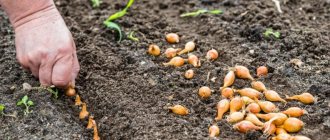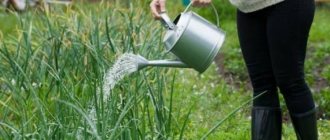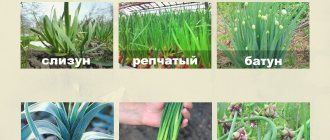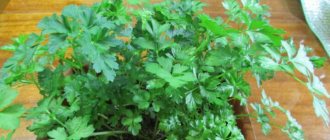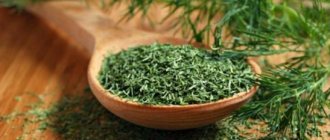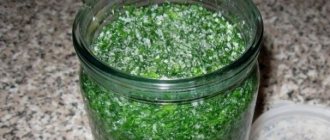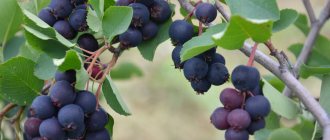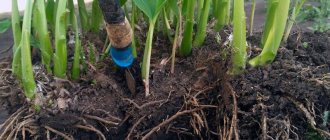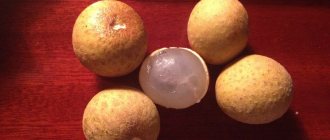To combine business with pleasure, you can grow chives in your garden. The culture will produce pleasant-tasting green feathers with medicinal properties, and during flowering it will become a real decoration of the garden bed. This onion is easy to care for and can please the gardener for many years.
Chives are often used in landscape design.
Chives are used to prepare salads and marinades
Chives are easy to care for
Description of the bow
Skoroda, chive, sibulet, winter bush, restaurant - and this is not a complete list of names of chives. It is also called Siberian because it is often found beyond the Urals.
Schnitt is translated from German as “cut” onion. Regardless of its name, it is a perennial herbaceous plant of the Allium family, which has been cultivated as a medicinal and ornamental plant since the 16th century. This onion has been used for food relatively recently. Its characteristics can be found below:
| Parameter | Description |
| Distribution area | In nature, chives are found in northern China and Mongolia. The plant grows in river valleys and well-moistened meadows, where extreme frosts rarely occur. The crop is grown on a large scale in the countries of Indochina, Europe and North America. In Russia, this onion is more often found in the Far East, northern regions and Western Siberia. |
| Bloom | Starts in May and continues throughout the summer. Ball-shaped inflorescences appear on the arrows. They consist of a large number of umbrellas with seeds inside. They can be any color of purple, lilac and pink. |
| Plant characteristics | Onion bushes are used to decorate the garden, as they look very aesthetically pleasing and have the following structure:
|
| Bulb characteristics | The underground part of the perennial plant acts as small false bulbs. They have an ovoid shape, which can be conical or oblong. These fruits are purple-red in color (in some varieties, brown-white), covered with brown paper-like shells and ending in short rhizomes. These bulbs contain a large number of amino acids, phytoncides, mineral salts and vitamins (C, A, PP, B1 and B2). Their nutritional value is:
|
| Seed material | In August, after flowering, a large number of small seeds are formed in the umbels, which later become black. Next season they can be used as seed. A flower arrow forms from each bulb in the second year after planting. In perennial plants they appear annually. |
| Application | The bulbs taste good, so they are actively used in cooking for preparing salads and marinades. They are especially indicated for cardiovascular pathologies, colds, spring vitamin deficiency and atherosclerosis. In addition, the vegetable has a positive effect on the functioning of the kidneys, liver and gall bladder. The juice of fresh leaves will help reduce the unpleasant symptoms of hemorrhoids. The ornamental plant is also used in landscape design to add greenery to garden plots. In addition, this onion will repel onion and carrot flies and suppress the activity of fungal spores, which pose a threat to roses, fruit trees and gooseberries. With their flowering, the bushes will attract the bushes, which collect nectar from its sweet umbrellas. |
Application
Chives are widely used in folk medicine to combat various diseases. Based on it they make:
- decoctions;
- infusions;
- compresses.
These drugs are successfully used in the treatment of many diseases:
- worms, constipation, hemorrhoids;
- purulent inflammation of the skin, fungus;
- cough, runny nose, bronchitis, pneumonia, flu, sore throat;
- hypertension and atherosclerosis;
- sexual dysfunction;
- scurvy;
- inflammation of the appendages, cervical erosion, etc.
Products based on chives have become equally widespread in home cosmetology:
- Face masks based on juice or pulp from the leaves are used to combat freckles and acne.
- Chives juice is rubbed into the scalp to strengthen weak hair or get rid of dandruff.
- Schnitt successfully fights calluses, foot fungus and dry skin.
Chives are highly valued for their usefulness and beauty. The plant is widely used in landscape design , as well as for decorating summer cottages. And the beneficial properties and chemical composition of the plant allow it to be used not only for food as a rich source of vitamins. But also to make on its basis:
- medicinal decoctions;
- compresses;
- masks.
Varieties of onions
There are two subspecies of chives:
- Alpine (Russian) . Has more intensive formation of stems. Its bushes are covered with a large number of tender leaves, which immediately begin to grow after cutting.
- Siberian . Unlike the previous subspecies, it forms larger and coarser leaves. The bushes branch somewhat weaker.
Both varieties of onions have good frost resistance, but the Siberian culture shows greater resistance to low temperatures.
During the growing season, the leaves of adult onions can withstand temperatures down to -8...-6°C, and young shoots - up to -4...-2°C.
Popular varieties
About 20 varieties of chives are included in the State Register of Breeding Achievements. The most popular among them are:
- Bohemia . It is allowed to cultivate the variety in the same place for 4 years. The first leaves can be cut 3 weeks after the start of the growing season. They have a pleasant semi-sharp taste. The productivity of Bohemia is high - up to 200 g of greenery per bush. The variety exhibits disease resistance.
- Spring . Leaves can be cut off a month after they begin to grow. The bushes will turn out tall and powerful. The leaves themselves are erect and covered with a thin waxy coating. They have a pleasant, slightly spicy taste. The yield of a winter-hardy variety for 3-4 cuttings is 6 kg per 1 sq. m.
- Honey plant . The leaves are suitable for mass collection 3 months after they begin to grow. At the same time, they can be selectively cut throughout the summer. The taste of dark green leaves with a waxy coating is semi-sharp. The disadvantage of Honey plant is its high susceptibility to peronosporosis.
- Crocus . Early ripening variety - the first cutting of leaves can be done within 2 weeks after the leaves begin to grow. They acquire a dark green color and become covered with a waxy coating. The variety is not particularly distinguished by its yield, which, moreover, sharply decreases after 3-4 years. Crocus shows resistance to spring frosts.
- Parisian . A sharp-tasting variety with early ripening. Produces long, dark green leaves that can be added to salads and marinades.
- Chemal . Quite compact chives, the leaves of which reach a length of up to 40 cm. Their taste is pungent. The disadvantage of this variety is its frequent infection with powdery mildew. Productivity is high - up to 7 kg per 1 sq. m. From one bush you can collect leaves with a total weight of up to 600 g.
Planting methods and timing
This herbaceous plant can be grown in gardens as a perennial crop or replanted every 1-2 years. It can be cultivated in two ways:
- Through direct sowing of seeds into the ground . A more popular technology that is used when growing onions in the garden for several years. Seeds can be sown directly into unprotected soil.
- Through seedlings . A more labor-intensive technology that allows you to get an early spring harvest of succulent leaves in the first year. Seedlings need to be prepared approximately 25-30 days before planting in the ground, so that by the time they are transplanted to a permanent place, the seedlings will have leaves about 10 cm high.
Regardless of the cultivation method, chives can be grown both in spring and before winter. In the first case, planting work should be carried out after the snow has completely melted, that is, from approximately the first half of March to the end of April. When planting in winter, sowing can be done from late September to early October.
Vitamin greens on the windowsill
The crop can be grown on a windowsill. In this case, the process will be much more pleasant and efficient than when planting ordinary leeks. The plant is a very suitable option for ornamental growth.
Note! If you grow chives at home, then it is worth considering that greens from a pot will not produce the same rich harvest as in the garden.
Planting and caring for onions in a pot includes the following steps:
- You need to prepare a spacious container (necessarily deep) and choose light and well-fertilized soil for planting seeds.
- Planting material is placed on the surface of slightly moistened soil. The container should be completely covered with glass. This is enough for their germination.
- When the first shoots appear, you need to remove the container with the seedlings to a shaded place, where the pot will remain in the future.
- Once every 2 weeks you need to water the plant with a solution of complex fertilizers. The dosage should be minimal.
Schnitt on the windowsill
If everything is done correctly, then in 1-2 months you can get a thick bush with emerald greenery.
Preparatory activities
Before planting work, you need to properly prepare both the soil and planting material. Let's figure out how to do this step by step.
Soil preparation
Chives are unpretentious to their predecessors, so they can be planted after almost any crop. It is advisable to place carrots near it, since these crops repel mutually dangerous pests.
The area itself should be moderately lit. It should not be overheated by the sun's rays, otherwise the leaves will grow too coarse.
As for the soil, onions love loose and well-drained soil. The best option is moist sandy or loamy soils enriched with lime. You should not cultivate the plant in areas with sandy soil, as it does not retain moisture well and is detrimental to this crop.
The marked place on the site must be prepared in advance: for spring sowing - in the fall, for winter planting - in the summer. The following steps are required:
- Dig up the area and remove the rhizomes of all weeds. These events should be taken seriously, since sibulet onions are often planted for many years.
- Lime acidic soils. Add sand to heavy clay soils, and 1 bucket of humus or 0.5 liters of compost per 1 square meter to all other soils. m. Of mineral fertilizers, it is worth applying 1 tbsp. l. superphosphate and urea per 1 sq. m.
- In the spring, a few days before planting, feed the area with ammonium nitrate or urea (15-20 g per 1 sq. m). Next, the beds need to be watered generously at the rate of 2-3 liters of water per 1 square meter. m and begin sowing activities.
Processing of planting material
Self-harvested or purchased seeds must be subjected to pre-sowing treatment. It is as follows:
- Pour warm water over the seeds and soak for 24 hours.
- Change the water regularly during soaking. This can be done 3-4 times.
- Take out the seeds, place them on a paper napkin or any cloth and dry them.
Ready seeds can be sown directly into the ground. After this treatment they will sprout much faster.
When planting in winter, it is advisable not to soak the seeds, since they need to be lowered into the ground completely dry.
What you need to grow onions
Unlike traditional varieties of onions, chives are grown as a perennial crop.
From a culinary point of view, cutting the young shoots of the plant is of interest. Because of this feature, it received the name chives. The species is distinguished by its ability to quickly grow numerous shoots. The false bulb grows up to 1 cm in diameter. Planting requires suitable soil in which greenery will grow for several months. The main requirements for the soil are a loose structure and neutral acidity. At home, you can grow chives in garden soil or purchase soil for vegetable seedlings at a flower shop.
Selection and preparation of containers
The container for planting is selected in accordance with the characteristics of the root system of the chives. It consists of many short shoots that intertwine with neighboring roots and form turf. The length of the underground part of the plant is no more than 5 cm. Up to 30 feathers are formed from one bulb in a short time.
In this regard, the optimal shape of the growing container is a low, wide container with drainage holes to drain excess water.
Before planting chives, it is necessary to wash the container with soda or soapy water and treat it with potassium permanganate. This measure helps to avoid the spread of bacteria in the soil. You should take care of a tray in which excess water will accumulate after watering.
Preparing onion seeds for planting
You can prepare planting material yourself if the plant grows in a summer cottage or in a garden. Otherwise, you can purchase seeds at the store. When choosing a variety, you should focus on the varieties of chives intended for cutting. Before planting, onion seeds are pre-treated using the following technology:
- Soak for a day in 100 ml of water with 3 drops of Epin-extra;
- Remove pop-up instances;
- The remaining seeds are soaked for half an hour in a pale pink solution of potassium permanganate;
- Wash under running water, dry for 2-3 hours on a paper towel.
Seed preparation promotes rapid germination, destroys harmful bacteria and fungal spores, and increases the protective functions of the crop. Epin activates metabolic processes, increases onion resistance to diseases and adverse conditions.
The shelf life of chives seeds is 2 years. Maximum germination is observed in fresh seeds.
Planting chives
When all the preparatory measures have been completed, you can begin planting the crop using a pre-selected technology. We will consider each option separately.
Direct sowing of seeds into the ground
You need to sow seeds into dug up and loosened soil, following this pattern:
- width between rows – 15 cm;
- distance between holes – 5 cm;
- embedment depth – 1-2 cm.
If the main crop is planned to be harvested in the second year, and the plantings are to be liquidated, the seeds can be sown more freely, keeping about 30 cm between rows. In strips, seeds need to be sown often, since they have low germination.
After sowing, the furrows should be sprinkled with soil and lightly compacted. Immediately before frost, the crops should be mulched using one of the following materials:
- sawdust;
- old newspaper;
- foliage;
- wood rot;
- spruce branches and rags.
When sowing in winter, the mulch must be removed in the spring, immediately after the snow melts, so that the seeds can sprout.
When sowing chives with seeds in the first year, it is advisable not to touch them, so that by the next season they will become stronger and bring a good harvest.
Seedling method
This technology, first of all, involves growing strong seedlings in early March. The step-by-step instructions are as follows:
- Preparing the container and substrate . Prepare a spacious box about 20 cm deep and fill it with a nutritious mixture of sand, humus and turf ash. You need to leave 3-4 cm of free space on top. Carefully level the soil, lightly compact it with your palm and water it generously from a watering can.
- Sowing . Seeds, prepared in the usual way or soaked in a solution of a growth stimulant (for example, Epinet), are sown to a depth of 1.5 cm in increments of 2-2.5 cm. Then lightly sprinkle them with the substrate, spray them with a spray bottle and cover with glass or film.
- Creating an optimal microclimate . When the first shoots appear on days 6-8, remove the covering material, move the seedlings to the windowsill on the sunny side and keep them at a temperature no higher than +18° and a humidity of at least 70%. Make drainage holes in the box as needed. During short daylight hours (up to 12 hours), organize additional lighting.
- Watering . Water the seedlings moderately as a dry crust appears on the surface of the substrate. The water should be warm.
- Thinning . In the phase of one true leaf, you need to thin out the planting, but it is best to sow the seeds more rarely.
At the age of 50-60 days, seedlings with 2 true leaves should be transplanted into open ground, following the following scheme:
- width between rows – 35-40 cm;
- the distance between seedlings in a row is 20-25 cm.
If the plant is actively growing, 1-2 cuttings can be made in the first year. From the age of 2, onions will begin to bloom and the frequency of cutting can be increased to 3-4 times per season.
Chives can be grown on the balcony. To do this, the seedlings do not need to be transplanted into the ground. If you feed the seedling 1-2 times a month with a solution of any complex fertilizer, already 2 months after the first shoots appear, you can begin cutting off the leaves.
To learn how to sow chives for seedlings, see the following video:
Planting in open ground
Chives can be grown either by sowing seeds directly into the garden bed or through seedlings. They begin to prepare it in March, and when the leaves reach a height of about 10 cm and the weather is favorable, they are planted in the garden. However, if there is no need to obtain an early spring harvest directly in the first year, this is not done: onions intended for growing in the garden for several years are sown with seeds directly into unprotected soil.
Site selection and soil preparation
Chives can be planted in the garden after almost any vegetable plants: they are not picky about their predecessors. He himself, like any type of onion, loves to grow next to carrots: these crops help each other, mutually repelling pests. An early harvest of greenery can only be obtained in well-lit beds. On the other hand, onion leaves become coarser faster in the sun, so partial shade would be a compromise for chives.
The garden bed has been prepared since the fall. Since this onion is usually planted for more than one year, it is especially important when digging to carefully remove the rhizomes of perennial weeds. Sand must be added to heavy clay soils, and humus or compost, as well as wood ash, to any soil. The norms are usual: about a bucket and 0.5 liters per 1 m2, respectively.
In the absence of organic matter, you can add superphosphate and any potassium salt to the soil (although this is not the best option), and in the spring, shortly before sowing, add 15–20 g of ammonium nitrate or urea.
How to prepare planting material
Those who have been growing chives for several years usually stock up on their own seeds, which is not difficult to do in the fall. You can also buy them in the store.
Chives seeds are usually a little smaller than chives, but they are treated the same way.
The seeds will sprout dry, but you can speed up this process. To do this, fill them with not too cold water and leave for a day, periodically (3-4 times during this time) changing the water. After soaking, the seeds are laid out on any cloth or paper napkin and allowed to dry until they flow, after which they are sown.
Sowing seeds
Typically, chives are sown in a garden bed in the spring, but autumn (winter) sowing is also possible. In the latter case, the seeds are sown dry to a depth of 2 cm, and mulched on top with a thick layer of sawdust or fallen leaves. This must be done immediately before the onset of frost. In the spring the mulch can be raked away and the seeds will soon sprout. However, spring sowing is most often used.
In the middle zone it is more convenient to sow at the very end of April, in the southern regions earlier. Onions are sown in pre-prepared furrows, which are watered from a watering can without a strainer. Planting depth is about 1 cm. The sowing scheme is convenient for the gardener: several rows are made in the garden bed or just one.
Many lovers plant a small amount of chives, only “for the first time.”
The scheme also depends on how long the bed is being organized. If we are talking about one year, it is advisable to grow seedlings and plant them densely, for example, according to a 15 x 5 cm pattern. If the main harvest is harvested in the second year and the plantings are eliminated, then the seeds are sown more freely. The distance between the rows is maintained at about 30 cm. You have to sow often in rows: the germination rate of chives seeds is not very good.
Shoots appear in 1–1.5 weeks (depending on the variety and weather). After the formation of 1–2 leaves, they are thinned out, leaving a distance in the row of 8–10 cm. After the second thinning (when the removed bushes can already be replanted), the distance is 15–20 cm. If it is expected that the onion will linger in this place 3–5 years, then there should be 25–30 cm between the bushes; In this option, the inter-row spacing can be increased to 40–50 cm.
I haven’t touched the four chives that grow in the garden for seven years now, I only water them occasionally. In early spring, we eat greens with pleasure, and then it’s time for other vitamin-rich plants, and somehow we forget about chives. Since it receives almost no care, it does not grow much.
Planting care
Onion is an unpretentious crop, but requires timely implementation of basic agrotechnical measures.
Watering
The plant needs systematic, abundant watering, although it can withstand short-term drying out of the soil. It needs to be watered “to satiety”, but at the same time avoid waterlogging. You need to use distilled water with no chlorine.
If you are late with watering, the onion leaves will turn out rough and lose their taste. In such a situation, you will have to cut off part of the crop, water the remaining bed generously, and then feed it and water it again.
Loosening and weeding
For long-term cultivation, these manipulations will only need to be carried out for 1-2 years. In the future, the plant will grow, form a dense turf and begin to suppress weeds on its own. In order to prevent pests after watering, the soil should still be slightly loosened and weeded, destroying all weeds.
Thinning
As soon as 1-2 true leaves form on the seedlings, they need to be thinned out, leaving 8-10 cm in the row between plantings. During the second thinning, when the removed bushes can already be replanted, the distance should be increased to 15-20 cm.
If you plan to leave the onion in the same place for 3 to 5 years, you should leave 25-30 cm between the bushes. In this case, the distance between the rows can also be increased to 40-50 cm.
Top dressing
There is no need to feed the crop in the first season. When the first cutting is done, the onions can be fed with the following fertilizers:
- mullein infusion (1:10);
- solution of bird droppings (1:10);
- wood ash (glass per 1 sq. m).
It is advisable to carry out such fertilizing after each cut. After such manipulations, you need to thoroughly wash the plant with clean water.
In the absence of organic matter, you can add nitrophoska or azofoska under the chives at the rate of 40-100 g per 1 sq. m. m. The second fertilizing with mineral fertilizers can be applied only after 2-3 cuttings.
You can refuse fertilizing if the greenery grows at an active pace every year.
Protection from diseases and pests
Compliance with competent agricultural technology will protect the plant from diseases. In the worst case scenario, they may be affected by:
- Downy mildew (peronosporosis) . It affects all parts of the plant, leaving behind large gray spots on which garden dust actively accumulates. The leaves dry out quickly, and subsequently the entire plant dies. At the first signs of disease, the plant should be sprayed with a 1% solution of Bordeaux mixture with the addition of 50 g of liquid soap per bucket of water.
- Rust . Irregular yellow-orange spots form on the plant. Soon it weakens and stops growing. To combat rust, affected specimens must be treated with Topaz or Falcon.
If any signs of damage appear on the onion, you should immediately cut off the damaged areas and burn them. It is advisable to water the soil itself with 5% table salt, and then with clean water. In the worst case, it is necessary to carry out complete disinfection and transplant the bushes to a new location.
As for pests, to repel them you need to spray the plantings with a solution of tobacco and liquid soap. Creosote-impregnated materials can also be placed along the bed.
Diseases and pests
Chives are resistant to diseases and pests, and prevention will help to avoid problems:
- Before planting, treat the seeds with special solutions;
- before planting, place the bulbs in water at 45 C for 10 minutes;
- keep the sods in the sun for several hours.
- By the end of the growing season, downy mildew (downy mildew) and rust can damage onions.
- Of the pests, chives are loved by the larvae of the onion secretive proboscis. She gnaws the stems from the inside. From the outside, these moves look like light strokes.
- The onion fly and leaf miner are also partial to chives.
Regular inspection of the plant will allow timely detection of damage from pests and diseases. Diseased areas must be removed and burned. To remove pests, treat the soil with a saline solution, and after 4 hours, water it with running water.
There are several hundred types and varieties of onions. We want to tell you about some of them in our articles. Read about these - batun onion, leek, slime onion, family onion, fragrant onion, as well as Exhibition, Russian size, Snowball, Aflatunsky and Karatalsky.
Propagation of chives by division
In favorable conditions, the onion grows strongly and completely covers the soil. As a result, crop productivity decreases, and feathers grow worse in older bushes. In addition, they quickly wither and acquire an unpleasant taste. To correct this situation, the crop needs to be replanted, dividing the bushes into several parts.
It is best to divide the plant at the age of 2-4 years, since it is strong and when breaking the mother bush, you can get many daughter parts. This manipulation is best carried out in the spring (no later than the foliage begins to actively grow) or at the very beginning of autumn. Propagate in this order:
- Water the bed generously.
- Dig the plant with a shovel or pitchfork and remove it completely from the ground.
- Trim the leaves and roots of the dug up bush to a length of 12-15 and 5-7 cm, respectively.
- Break the bush with your hands or using a knife into several parts, leaving at least 8-10 bulbs on each.
- Immediately plant the resulting fragments in a new place, adhering to the usual planting pattern. The optimal distance between them is 30 cm.
- Water the new planting generously, and in cold weather or on the eve of frost, mulch with peat or humus.
Transplanted plants will quickly sprout new shoots.
Cutting greens and storing them
From the second year of cultivation, you can start cutting greenery. Depending on personal needs, you can cut off several feathers or almost the entire above-ground part. During the season, you can make from 2 to 4 complete cuts of leaves, reaching a height of 25-40 cm.
The last harvest should be carried out no later than mid-August so that the plant can accumulate the required amount of nutrients before the onset of cold weather.
If you do not plan to collect seeds, then the arrows at a young age can also be eaten along with the leaves. When harvesting, you should leave short feathers on the bush. During the flowering period, onion feathers become too tough and not tasty, so when growing it for food, it is advisable to immediately remove the inflorescences.
You can store collected greens for up to 2 weeks. To extend this period, it must be placed in plastic containers or bags and stored in the freezer. Feathers can also be dried.
Benefits and harms
Chives leaves and bulbs are rich in:
- carbohydrates;
- proteins;
- fats;
- microelements.
Contain:
- vitamins K, C, E, A, B;
- minerals (calcium, magnesium, iron);
- ascorbic and folic acids.
Using chives in food strengthens the immune system. Having an antiseptic and antimicrobial effect, the plant supplies vitamins to the body, reduces inflammation and bleeding of the gums, and helps in the fight against infections and parasites.
However, excessive consumption of chives can negatively affect the body:
- provokes chronic liver disease;
- provokes flatulence;
- promotes the growth of calcifications, which affects kidney function;
- worsens heart function;
- may cause blockage of blood vessels;
- increases blood pressure.
Onions irritate the intestinal mucosa and increase its acidity.
Therefore, patients with gastritis, ulcers, diseases of the cardiovascular system, liver and allergies are not recommended to eat chives. Attention! In order not to harm your body and not suffer from worsening of the disease, you should consult a specialist.
Landscape design
Chives can be grown exclusively as an ornamental plant, planted in a stripe in a border or as a border along a flower bed. If you divide one adult bush, you can get a border up to 2 m long. It will turn green literally 7 days after planting, and if you trim it regularly, you can maintain the brightness of the greenery in the border.
The plant not only decorates the garden plot, but with its aroma it also attracts insects beneficial to the garden - bees, bumblebees and butterflies.
You can combine this culture with low flowers. These include:
- daisies;
- viols;
- primrose.
If during the flowering period the leaves of the chives begin to turn yellow, the bushes need to be completely trimmed to a height of no more than 5 cm. Young feathers will appear within 5 days, and the plant will quickly return to its attractive appearance.
Chives are both a vegetable and an ornamental plant, with which you can decorate your garden plot, and in early spring you can cut off the juicy, sweet-spicy and very fragrant green feathers. Despite this versatility, this plant does not require special care and can grow in one place for many years.
0
0
Copy link
